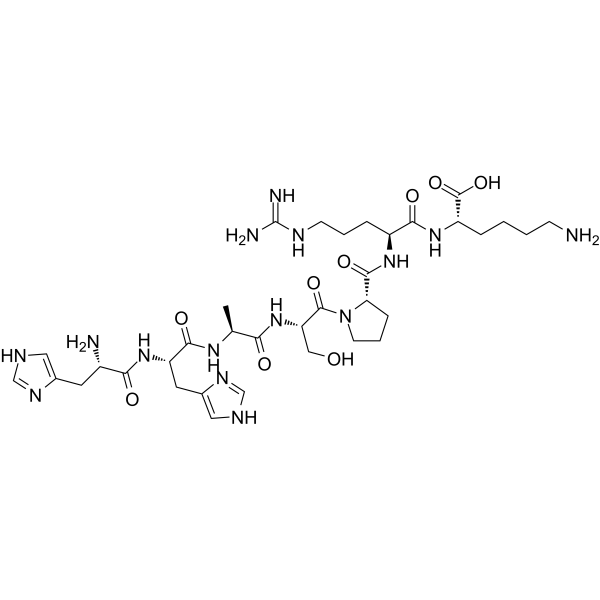
CDK2
CAS No. 255064-79-0
CDK2( —— )
Catalog No. M30573 CAS No. 255064-79-0
CDK2 is a member of the eukaryotic S/T protein kinase family and its function is to catalyze the phosphoryl transfer of ATP γ-phosphate to serine or threonine hydroxyl (denoted as S0/T0) in a protein substrate.
Purity : >98% (HPLC)
 COA
COA
 Datasheet
Datasheet
 HNMR
HNMR
 HPLC
HPLC
 MSDS
MSDS
 Handing Instructions
Handing Instructions
| Size | Price / USD | Stock | Quantity |
| 5MG | 392 | Get Quote |


|
| 100MG | Get Quote | Get Quote |


|
| 200MG | Get Quote | Get Quote |


|
| 500MG | Get Quote | Get Quote |


|
Biological Information
-
Product NameCDK2
-
NoteResearch use only, not for human use.
-
Brief DescriptionCDK2 is a member of the eukaryotic S/T protein kinase family and its function is to catalyze the phosphoryl transfer of ATP γ-phosphate to serine or threonine hydroxyl (denoted as S0/T0) in a protein substrate.
-
DescriptionCDK2 is a member of the eukaryotic S/T protein kinase family and its function is to catalyze the phosphoryl transfer of ATP γ-phosphate to serine or threonine hydroxyl (denoted as S0/T0) in a protein substrate.(In Vitro):CDK2 (Cyclin-dependent kinase 2) is a member of the eukaryotic S/T protein kinase family and its function is to catalyze the phosphoryl transfer of ATP γ-phosphate to serine or threonine hydroxyl (denoted as S0/T0) in a protein substrate. The fully active CDK2 is in complex with HHASPRK (an optimal peptide substrate), namely interactions of CDK2 with peptide substrate and the dynamics of the G-loop. CDK2 participates in eukaryotic cell cycle regulation at the G1/S boundary. CDK2 deregulation has been proved to occur in tumor cells, evoking a strong interest in artificial and native inhibitors. CDK2 activity is tightly regulated by a complex mechanism, including a positive regulatory subunit binding, and phosphorylations at positive and/or negative regulatory sites.
-
In VitroCDK2 (Cyclin-dependent kinase 2) is a member of the eukaryotic S/T protein kinase family and its function is to catalyze the phosphoryl transfer of ATP γ-phosphate to serine or threonine hydroxyl (denoted as S0/T0) in a protein substrate. The fully active CDK2 is in complex with HHASPRK (an optimal peptide substrate), namely interactions of CDK2 with peptide substrate and the dynamics of the G-loop. CDK2 participates in eukaryotic cell cycle regulation at the G1/S boundary. CDK2 deregulation has been proved to occur in tumor cells, evoking a strong interest in artificial and native inhibitors. CDK2 activity is tightly regulated by a complex mechanism, including a positive regulatory subunit binding, and phosphorylations at positive and/or negative regulatory sites.
-
In Vivo——
-
Synonyms——
-
PathwayOthers
-
TargetOther Targets
-
Recptor——
-
Research Area——
-
Indication——
Chemical Information
-
CAS Number255064-79-0
-
Formula Weight831.92
-
Molecular FormulaC35H57N15O9
-
Purity>98% (HPLC)
-
Solubility——
-
SMILES——
-
Chemical NameSequence:His-His-Ala-Ser-Pro-Arg-Lys
Shipping & Storage Information
-
Storage(-20℃)
-
ShippingWith Ice Pack
-
Stability≥ 2 years
Reference
Bártová I, The mechanism of inhibition of the cyclin-dependent kinase-2 as revealed by the molecular dynamics study on the complex CDK2 with the peptide substrate HHASPRK. Protein Sci. 2005 Feb;14(2):445-51.
molnova catalog



related products
-
Esonarimod
Esonarimod is an antirheumatic drug.
-
Hispolon
Hispolon is a polyphenol. Hispolon can be isolated from Phellinus linteus. Hispolon exhibits anticancer, antidiabetic, antiviral, hepatoprotective, antioxidant, and anti-inflammatory activities.
-
H-D-Phe-Pip-Arg-pNA ...
H-D-Phe-Pip-Arg-pNA (S-2238) dihydrochloride, a chromogenic substrate, is patterned after the N-terminal portion of the A alpha chain of fibrinogen, which is the natural substrate of thrombin. H-D-Phe-Pip-Arg-pNA dihydrochloride is specific for thrombin and is used to measure antithrombin-heparin cofactor (AT-III). The AT-III assay using H-D-Phe-Pip-Arg-pNA dihydrochloride is sensitive, accurate, and easy to perform.



 Cart
Cart
 sales@molnova.com
sales@molnova.com


